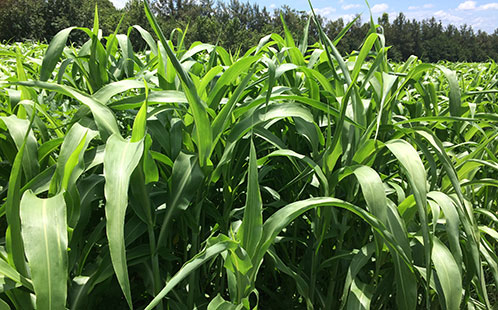Western Sydney University scientists find crops with narrower leaves better for future climates
 Maize is one of the world's most widely-grown C4 crops but require regular water to thrive in warmer climatic conditions.
Maize is one of the world's most widely-grown C4 crops but require regular water to thrive in warmer climatic conditions.
Our planet is becoming warmer with more frequent heat and drought stress events. Finding crops that are more productive and can tolerate these conditions whilst using less water in less arable land, is now a priority.
In a paper published this week, a team of scientists have found that varieties of crops like corn and sorghum with narrow leaves would be more water use efficient and possibly, more productive.
“We wanted to know if leaf size affect other processes that happen inside the leaf during photosynthesis, especially in relation to the use of water, and we found that it does,” said Dr Javier Cano, from the ARC Centre of Excellence for Translational Photosynthesis (CoETP) and the lead author of the paper published this week in the journal New Phytologist (opens in a new window).
“The implications of this study for breeders are huge, as narrow leaves may allow more light to enter into the lower leaves of the crop canopy which will increase photosynthesis in those usually shaded leaves and therefore, productivity.”
“Also, farmers could increase the density of plants in the field to compensate for the reduction in leaf area at the plant level, while reducing evaporation of water through the soil and diminish the competition for resources with weeds, especially during the early growth stages after germination,” said Dr Cano, from Western Sydney University’s Hawkesbury Institute for the Environment.
“These results are exciting because they show that just by changing a property at the leaf scale, we can increase water use efficiency at the canopy level and, possibly at the field level,“ he said.
The scientists focused their study on species that use C4 photosynthesis. This type of photosynthesis, used by plants such as corn, sugarcane and sorghum, is more water use efficient and drought tolerant than plants like wheat and rice, which use the ancient C3 photosynthesis process.
Scientists understand quite well what is happening inside the leaves of C3 plants, but not much has been done on C4 plants because they are much more complex and difficult to predict.
“Unlike C3 plants, little is understood about what controls water use efficiency in C4 plants, mainly because we didn’t have a precise tool to quantity this characteristic, so we have created it” said Associate Professor Oula Ghannoum (opens in a new window), CoETP Chief Investigator, who is a co-author of the study.
“We have developed the first C4 photosynthesis model that takes into account eight limiting processes including conductance of water and gases through the pores of the leaf and enzyme activity,” said Associate Professor Ghannoum, from Western Sydney University’s Hawkesbury Institute for the Environment”.
The scientists analysed a range of C4 grass species that have very different leaf sizes and belong to three different biochemical subtypes.
“Our study is the only one that has analysed C4 grasses across the three subtypes, taking into account the very specific kinetics of each subtype for Rubisco, the most important photosynthetic enzyme,” said co-author and CoETP researcher Dr Rob Sharwood from The Australian University (ANU).
“Our next step is to analyse all the leaf anatomical variables of the different subtypes. We also want to test the results in a model crop to see what effect leaf size has on productivity and water use efficiency, but our preliminary results are very promising,” he said,
This research is published in New Phytologist and was funded by the Australian Research Council (ARC) Centre of Excellence for Translational Photosynthesis (CoETP) at Western Sydney University’s Hawkesbury Institute for the Environment and The Australian National University, with collaborators from Washington State University in the USA.
The New Phytologist paper or abstract is available from: http://nph.onlinelibrary.wiley.com/doi/abs/10.1111/nph.15920
ENDS
7 May 2019
Mobile options:

